Inspired by the Lotus Elan, the Mazda Miata has become the ultimate entry-level two-door sports car for budding enthusiasts.
This nimble roadster is an equally appealing prospect for daily errands as well as the occasional weekend at the track.
It’s not a fast machine by any stretch of the imagination, but it’s not the slowest car in the world either.
However, with some modest tweaks, you can make the Miata a lot more exciting than its stock avatar. And if that doesn’t cut it, there’s always the option of ditching the factory 4-pot in favor of a beefier motor.
In this article, we’ll discuss the best engine swap ideas for the Mazda Miata. Options are plentiful, with builds ranging from LS V8s and 2JZs to rotary swaps and K24s.

But first, you want to choose the right chassis/generation. While NC and ND are undoubtedly more sophisticated, early NA and NB models are ideal for something like this.
Most enthusiasts prefer the 1st (NA) and 2nd generation (NB) Miatas when it comes to engine swaps, primarily because the aftermarket support is pretty generous.
You’ll find several conversion kits, auxiliaries, and all the necessary items for your build without much hassle. Before we get down to brass tacks, let’s discuss some of the more pocket-friendly alternatives.
Forced Induction or Engine Swap?
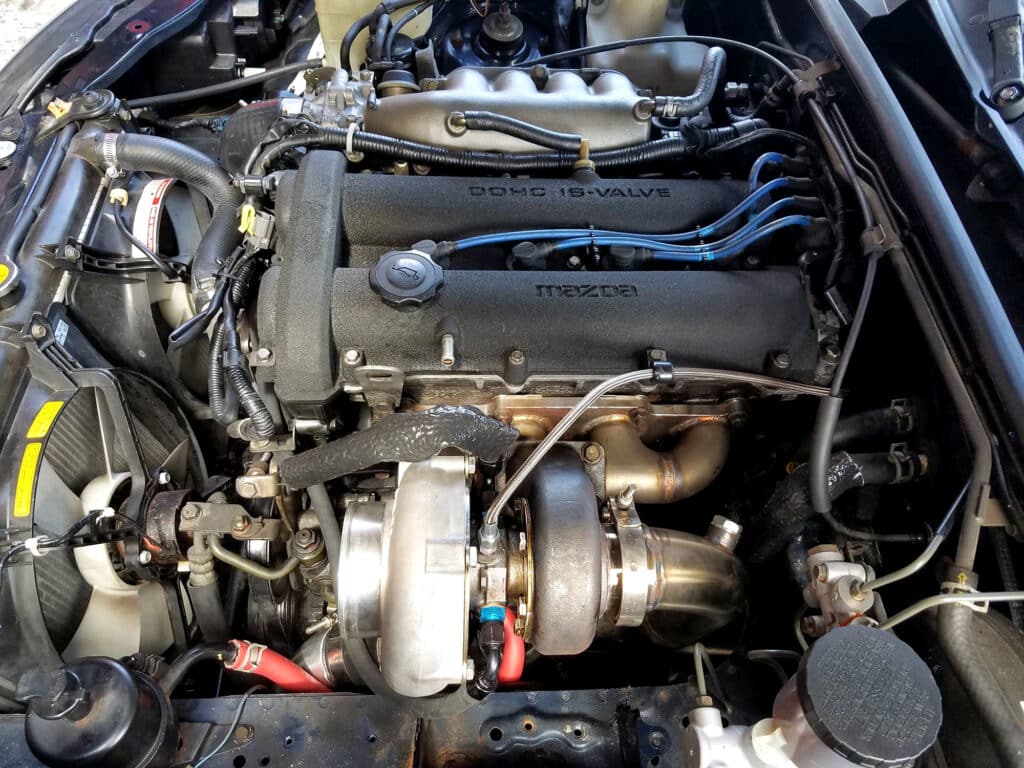
Considering how an engine swap could set you back thousands of dollars, it’s a wise choice to look for other ways to add power to your Miata.
Since the 1.8L 4-pot is fairly robust and takes kindly to forced induction, we suggest looking into turbocharger and supercharger kits for your Miata.
Depending on the generation, the naturally aspirated 1.8L motor will make up to 142 hp. Some NA Miatas have a 1.6L engine, and those make 116 hp in their most powerful configuration.
We can all agree that both those engines are underwhelming. But there are several aftermarket options that allow you to get more power out of them without burning a hole in your pocket.
There are examples of boosted Miatas with over 500 hp. In fact, bolting on a turbo or a supercharger is far cheaper than swapping out the engine for a new one.
While we wouldn’t recommend pushing the limits, 200-250 hp is a safe bet if you’re going the boosted route. Considering how light the car’s chassis is, the whole package should be an absolute belter to drive.
Of course, if that’s not enough, you could push for 500 hp, assuming the budget includes upgrading the engine internals for better reliability and peace of mind.
Approximate Cost
If your Miata has a blown engine and you’re at the point of no return, then it makes sense to consider swapping the stock motor for something more exciting.
But it’s not as easy as you might think. Engine builds are extremely labor-intensive and require a ton of experience. If you’re new to this, we suggest getting it done with the help of a professional. That, however, will cost you.
MX5 engine swaps can range from a few thousand dollars to as much as $50,000, depending on how comprehensive the build is.
There are, of course, several variables involved. If it’s an exotic engine, that alone could cost north of $10,000, depending on the type and condition.
For instance, swapping a Hellcat V8 into your Miata will cost well over $16,000 — that’s excluding the transmission, engine mounts, accessories, and labor.
So, the question is, which engine should you consider swapping into a Mazda Miata? Here are some of the more popular and relatively accessible conversions you can consider.
What Engines Should I Consider?
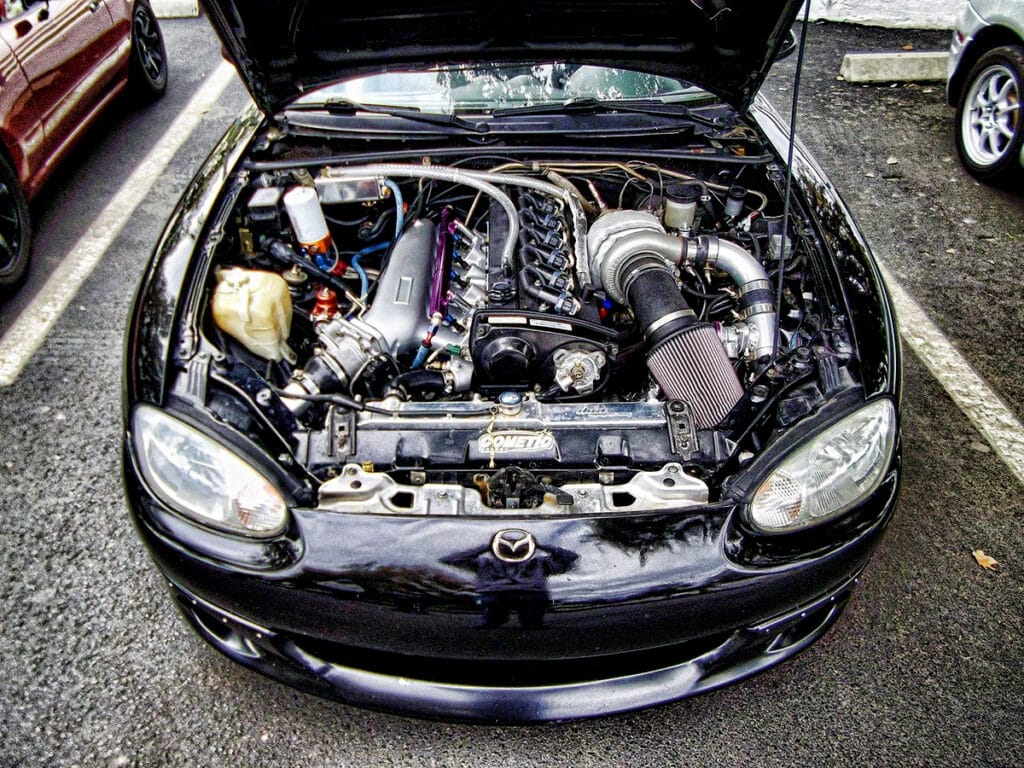
Inexpensive is perhaps the last word we’d ever associate with engine swaps. Honestly, there’s no such thing as a cheap engine build. It all boils down to how much you’re willing to spend.
So it’s important that you know what you’re after. Additionally, make sure you have planned and budgeted enough.
Before you proceed, it’s best to figure out your intentions with this engine swap and how it fits into your overall budget.
Set a realistic goal before jumping on a random build thread you found on the internet. There are quite a lot of these available, ranging from LS swaps and 2JZs to 13Bs and K24s.
LS Swapping a Miata
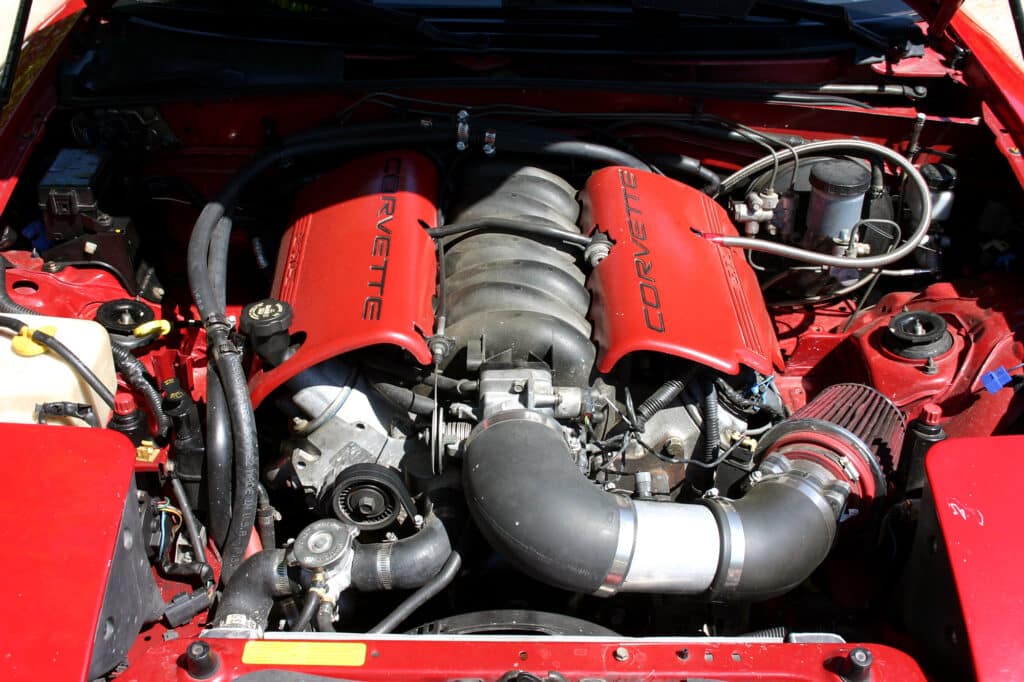
The most common Miata engine swap option is GM’s range of LS motors. These engines are the most popular choice for many project cars, let alone a Miata.
Of course, it’s not cheap, but you already guessed that. The advantage here is power, aftermarket support, and the number of cylinders.
Swapping a V8 over a tiny 4-banger is a serious upgrade. It’s worth noting that V8 swapping your Miata will strip away its beginner-friendly tag.
The driving experience is very involving — you’ll find yourself fighting the steering wheel at every turn.
Another issue is that you’ll be traction limited unless you install much wider tires and increase your wheel track width. This will require fender flares or a wide body kit. It’s a very tedious swap to work on as everything is very cramped under the hood.
The V8 also weighs quite a lot, so that’s something worth noting if you’re concerned about weight distribution, center of gravity, and things like that.
As to which LS engine you should choose, there are quite a few. Again, budget is the deciding factor here.
If money is no object, by all means, go ahead and install an LS9 in there. But the more popular choices are LS1 and LS3.
If you can do the job yourself, great. You’ll be saving a ton of money. It’s relatively easy for someone who’s not new to wrenching.
There are quite a few guides available online, and most Miata-specific forums have very well documented information on how to go about the build.
Swapping a 2JZ Engine in a Miata
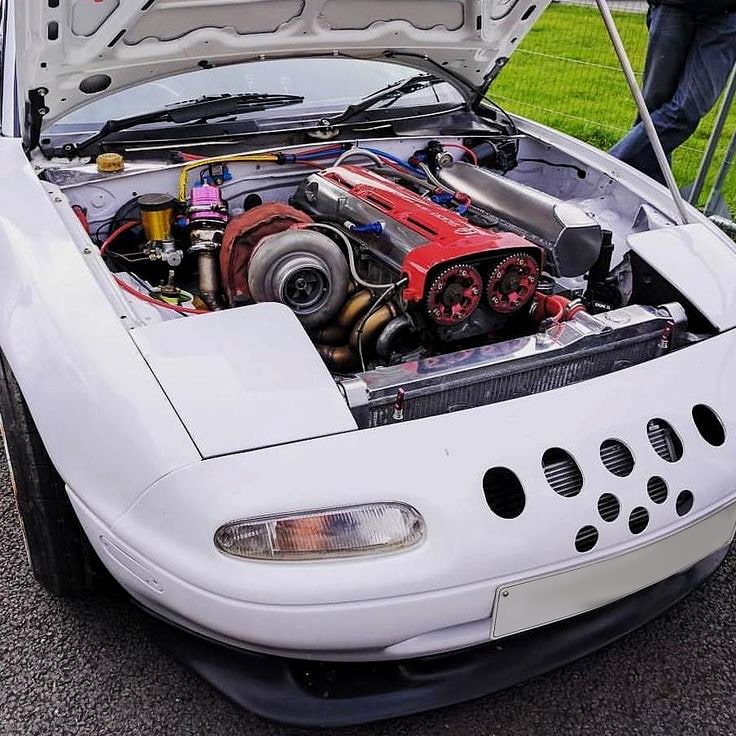
A quick internet search will reveal several examples of 2JZ-swapped Miatas. However, instead of the coveted 2JZ-GTE, many Miata owners prefer the more affordable 2JZ-GE.
Alternatively, 1JZ engines are also worth considering. Both 1JZ and 2JZ engines are robust and can handle a lot more power than they’re designed for.
The 2JZ-GE is the more common version powering run-of-the-mill cars, with outputs between 212 hp and 227 hp, while the GTE is a factory turbocharged high-performance motor producing up to 320 hp.
Both engines share the same bore and stroke, but the GTE, for obvious reasons, has several noticeable upgrades over its non-turbocharged counterpart. They are heavy engines; 2JZ-GE is close to 440 lbs, while the GTE is over 600 lbs.
The 2JZ-GTE is revered among enthusiasts as a bullet-proof motor. But the reality is that the 2JZ-GE is just as good, if not better.
In terms of tuning potential, a non-turbo 2JZ with stock internals is good for around 700-800 hp, which is pretty much all that a stock 2JZ-GTE can reliably handle. So ideally, a 2JZ-GE turbo build would be our top choice.
It’s not uncommon to see 2JZ-powered Miatas, but we’d like to point out that they’re not as popular as LS swapped Miatas; the primary reason being cost. The 2JZ-GTE is a fairly exotic motor and so demand is pretty high.
While the 2JZ-GE is more common and relatively affordable compared to its turbocharged GTE cousin, they won’t be nearly as cheap as a junkyard LS, for example.
Rotary and V6 Engine Swaps in a Miata
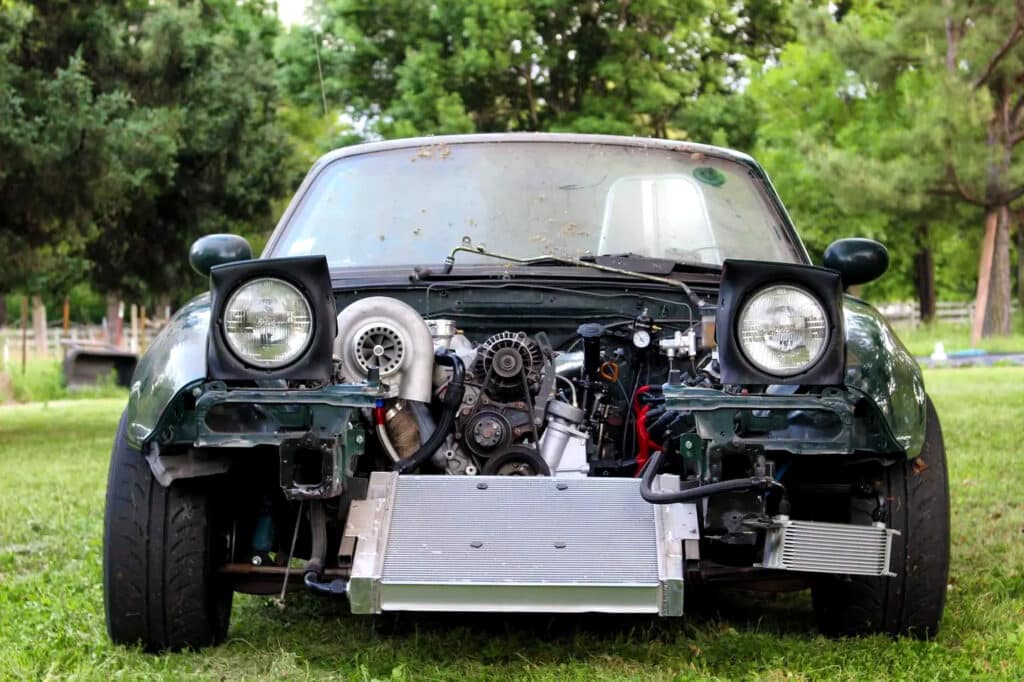
Miata with a Wankel engine sounds about right. While there are quite a few variations of these available, the 13B twin-rotor is the most common option.
However, we must point out that rotary-swapped Miatas can turn out to be very heavy on the pocket if not maintained properly.
The thing about rotary engines is that they need a bit more attention and more TLC than what regular engines need. They aren’t badly designed, but more often than not, they can be hard to deal with.
The 1.3L motor puts out up to 232 hp in stock form and has excellent aftermarket support.
Its main highlight is that it loves being redlined. The stock 13B is capable of nudging the 9,000 rpm mark. But there are accounts of rotary engines reaching an astonishing 11,000 rpm!
If peace of mind is what you’re after, then GM’s LFX V6 is worth considering. The 3.6L motor is bigger and bulkier than a rotary, but it’s fairly robust and has decent tuning potential.
An LFX-swapped Miata could be your ticket to a sensible 300 hp build. However, you might want to swap out the stock gearbox.
Powering Camaros and Cadillacs, the LFX V6 is fairly torquey and could tax the Miata’s stock transmission.
Realistically, it’s not impossible to finish an LFX swap under $10,000 and there are examples of people who have done it for far less.
If V8s aren’t your thing, this V6 will surely be of interest, especially considering it has a 7,200 rpm redline.
Honda J-series and K-series Engine Swap
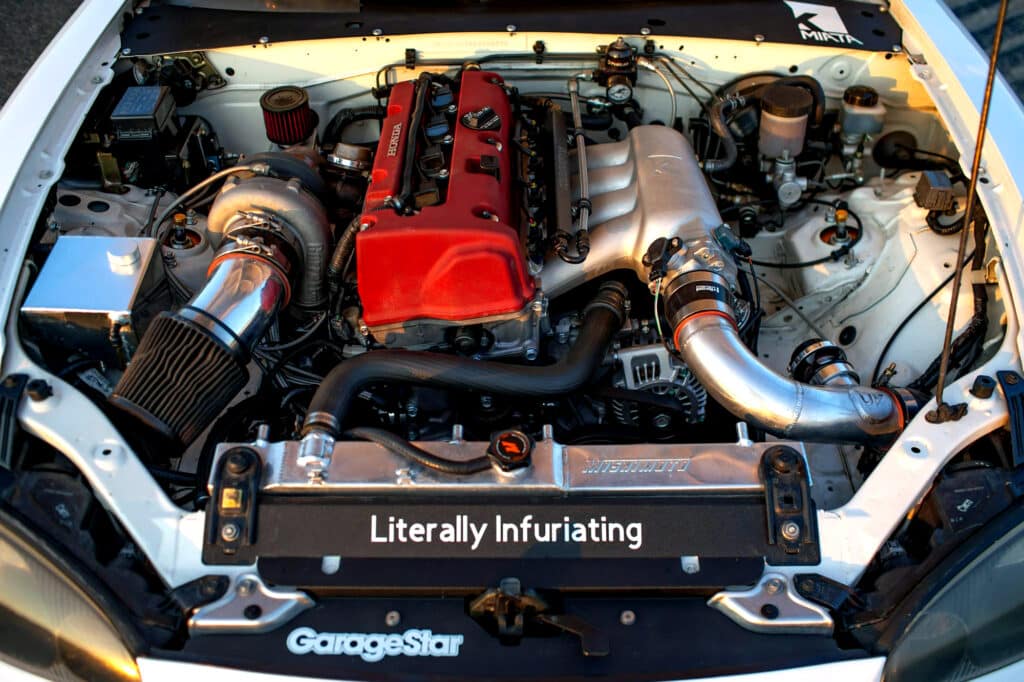
Since we’re on the subject of V6s, why not try Honda’s J-series? Found in several Honda cars, this ~300 hp motor (in 3.5L guise) is a perfect choice for those looking for a fairly reliable and easily sourced engine.
Another advantage is that the V6 (in its lightest configuration) shares similar weight specs to the Miata’s 1.8L while delivering better torque. You can count on it to not stray too far from the OEM weight distribution.
Aftermarket support is pretty decent, and sourcing the engine cheap won’t be a huge deal. Moreover, you get to enjoy the sweet 6-cylinder V6 sound, although it may not be to everyone’s taste.
If you prefer the dynamism of an inline-4 engine, it’s a good idea to look at Honda’s K-series engines. Specifically, the K20 and K24.
The former has quite the reputation for being one of the best Honda engines ever made. Tuners around the world consider it an ideal choice for swapping into all kinds of project cars.
As for the K24, it’s a similar story, with excellent aftermarket support and raving reviews from tuners across the globe. At 2.4L, the K24 is a relatively large engine compared to the 2.0L K20. That said, both engines have different characteristics.
The latter strikes a good balance between high rpm performance and torque. On the other hand, the K24 has better low-end torque thanks to its longer stroke and under-square design.
K-series engines are also pretty reliable and can easily cross the 300 hp mark without needing to install a turbocharger.
Swapping Nissan’s SR20 Into a Mazda Miata
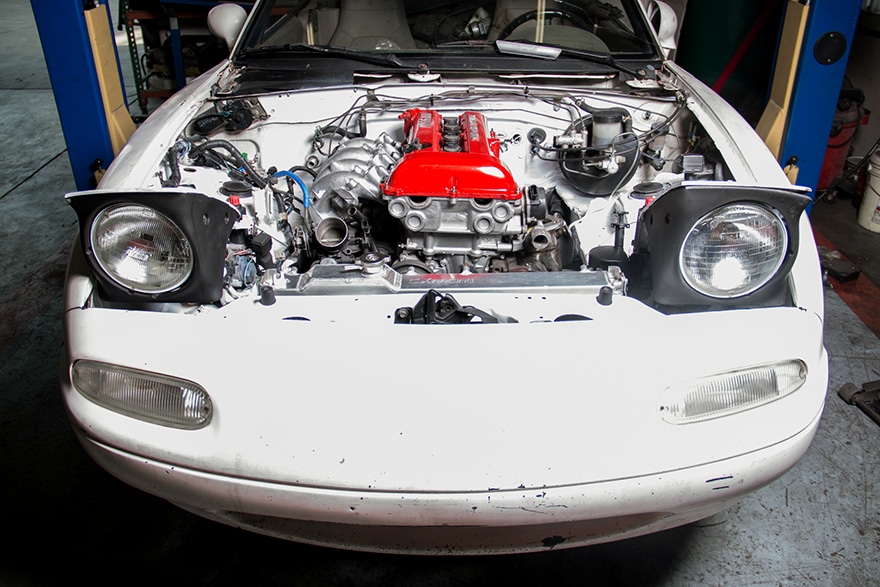
The SR20 is an excellent engine choice for swapping into your Miata. Since the 4-pot is factory turbocharged and comes with decent power figures, it’s worth looking at the SR20DET.
Perhaps the most versatile motor from the Japanese marque, the SR20 came in a variety of options, with its turbocharged DET avatar being a favorite. It’s a square engine, offering healthy amounts of power and torque without much compromise.
The engine is slightly on the heavier side, but that’s not to say it’s incompetent. The stock motor makes up to 250 hp.
If that’s not enough, reaching insanely high horsepower numbers is possible if you upgrade the internals and remap your ECU.
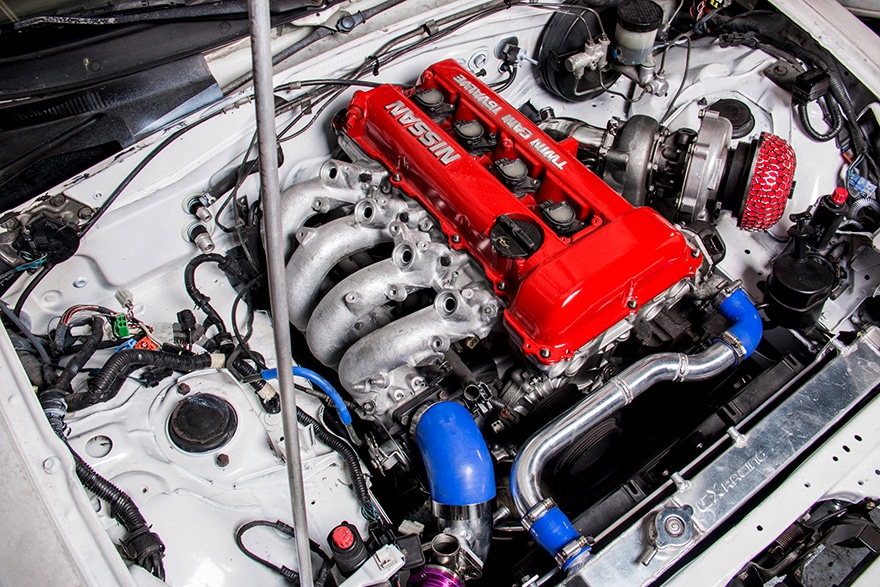
The SR20’s attainability is yet another attractive prospect. Aftermarket support is great, and parts are relatively cheap. Also, unlike its more coveted Japanese counterparts, building one from the ground up doesn’t require deep pockets.
You might also want to consider the RB20. The SR20 is a 4-pot, while the RB is a straight-6 motor; peak outputs differ, and stock internals are slightly beefier on the RB.
If you’re into tuning, the RB20 is a better pick, thanks to its cast-iron block and cylinder heads over the SR20’s all-aluminum design. Although these engines garner quite the demand, they aren’t absurdly priced like the more-coveted RB26.
Mazda Miata Engine Swap Kits
When it comes to engine swaps, off-the-shelf kits are perhaps the easiest way to get the job done. A quick glance at Flyin Miata’s roster reveals the extensive list of products they offer for the Miata platform.
While they previously did V8 swaps, nowadays the company no longer offers the option to its customers. However, that doesn’t mean that V8s are completely out of the equation.
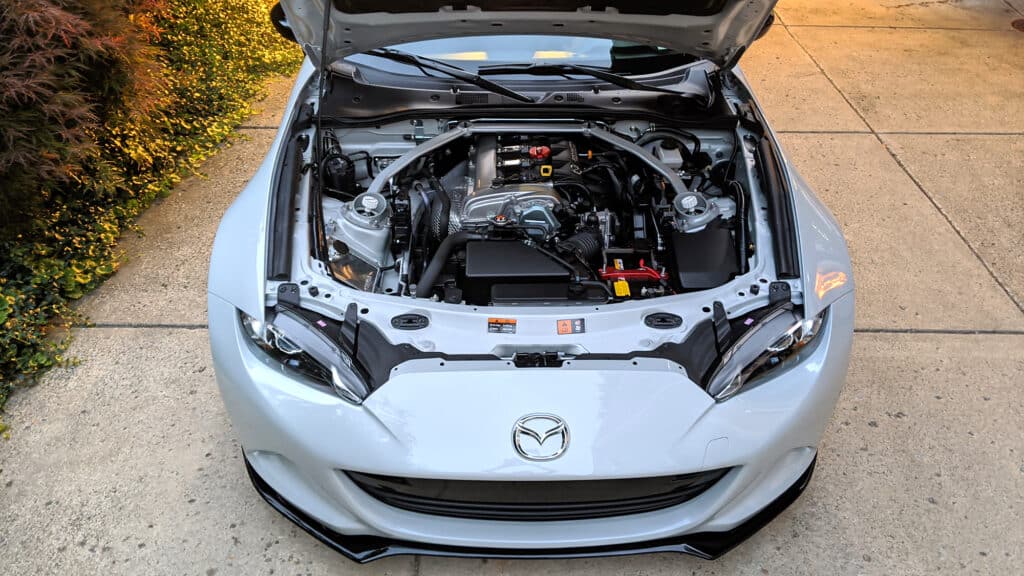
Head over to V8Roadsters or LSXEverything; you’ll find enough products to fulfill your goals of an LS-swapped Miata.
If you can’t find what you’re looking for (which is highly unlikely), MiataRoadster and CX Racing are also worth checking out.
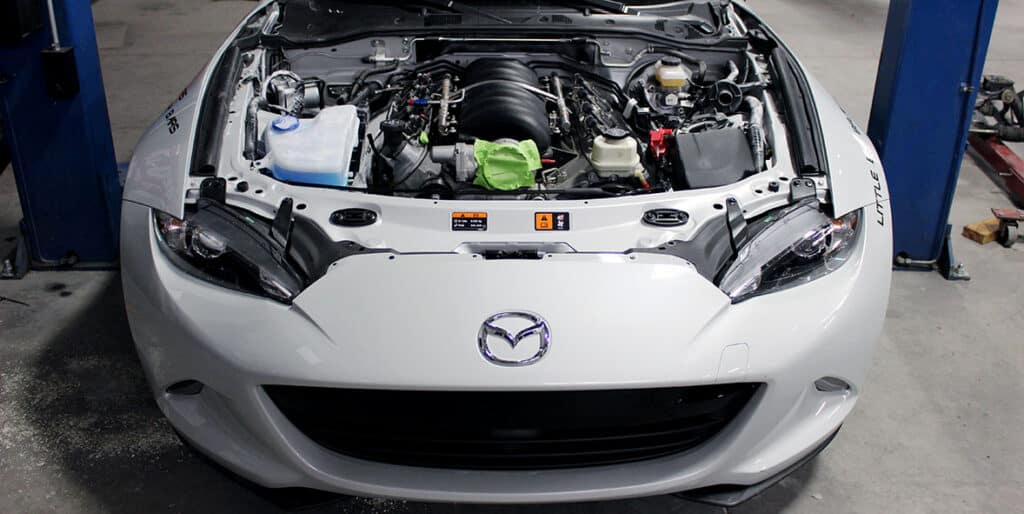
Opting for a swap kit will dramatically reduce your build time. However, these aren’t cheap. Something as simple as an LS intercooler upgrade will set you back around $900.
Alternatively, you can avoid shopping online and find these engines organically. But there’s a risk associated with that. You’re likely to make compromises on the quality and reliability front.
If you have a large enough budget, it’s best to purchase parts with a warranty. But if you’re strapped on cash, we suggest waiting for good deals to pop up.
Sure, they won’t be ultra cheap, but hey, you get to save some money, which could come in handy at some point in your build process.
The Best Miata Engine Swap Options
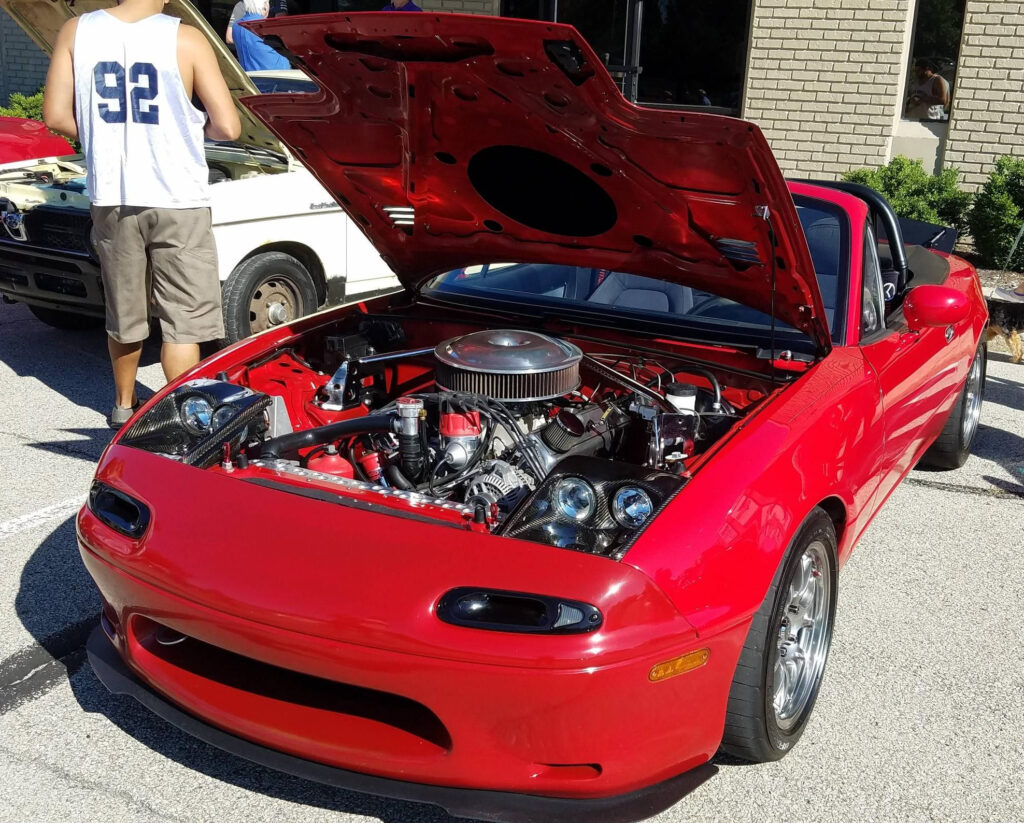
Now that we’ve gone through the engines and various swap kits, let’s assess which engine swap is best for the Miata platform.
Although there are swap kits available for most engines, we suggest choosing a configuration that’s as close as you can get to the 1.8L.
In other words, it’s best to swap a 4-pot engine that weighs nearly as much as the Miata’s stock motor.
By doing so, you don’t disturb the car’s dynamics, in turn saving you a bit of money that you’d otherwise spend/have to spend in order to upgrade the handling.
Honda’s K20 and K24 are excellent choices. Both engines weigh around 300 lbs (K20 being lighter), which is about the same as the Miata’s 1.8L motor. We’d lean towards the K24 as it can be sourced relatively cheaply in contrast to the K20.
However, availability is pretty much the same with some sources even pricing them identically. Also, the price largely depends on what version of K20/K24 you’re looking for.

That’s not to say a V8 or V6 would be a difficult project to undertake. As mentioned previously, there are several swap kits to choose from.
If you live in North America, we recommend swapping an LS V8, because of how easy it is to source.
Conversely, overseas customers may find it easier to source some of the JDM engines cheaply as they were sold in Europe alongside the Japanese market.
As to which is the easiest build, there’s really only one answer to that: None. Taking it to a shop is perhaps the closest thing to an effortless build. It’s worth noting that every swap project, regardless of the engine, will test your patience.
It’s not a weekend job. If you are to get the swap done from a professional shop, it’s going to set you back thousands of dollars just for labor. DIY is the most economical route, but then again, it’s not for everyone.
Concluding Thoughts
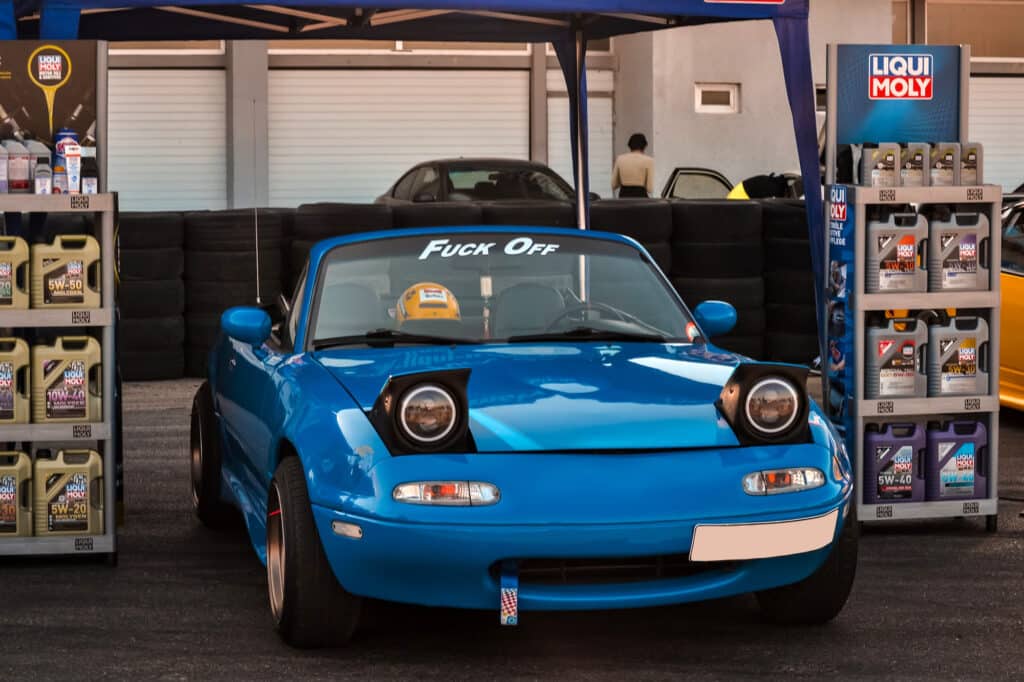
The Mazda MX5 is an excellent platform for upgrades, be it turbos, chassis mods, or engine swaps. The car itself is cheap to source and has go-kart-like handling.
Sure, the stock 1.8L engine lacks punch, but that can easily be fixed with a decent set of mods. Swapping the stock motor for another one will not be cheap, but the driving experience will be well worth the effort and money.
Choosing the right engine is not easy, neither is carrying out the build all by yourself. However, the experience will definitely be worth it. Plan, budget, and make sure you do your research.
There are plenty of parts, swap kits, and aftermarket mods for your Miata to choose from.
If you have the money to spend on a high-power build, go right ahead. The two-door roadster is a brilliant little machine with a ton of potential.
If you enjoy this article and find it informative, do let us know by leaving a comment down below!
Feel free to share it with your friends on Reddit, Facebook, or other social media platforms of your choice. We appreciate your support!

